News
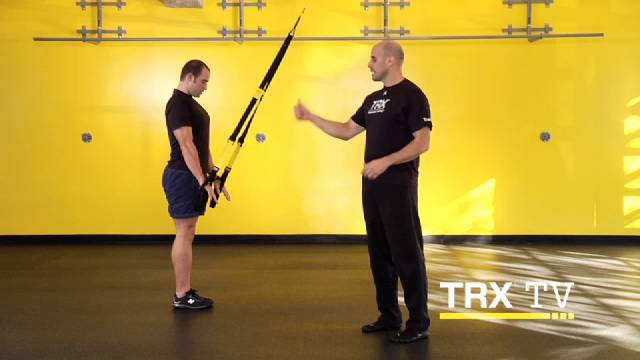
TRX for Iliotibial Band Syndrome (ITBS) - Part 1
With many of you training for running events this year, we wanted to share this article from physical therapist Chris Nentarz on common injuries that plague runners, and what you can do to avoid them. (Hint: it involves the TRX Suspension Trainer.)
Most running injuries stem from overloading, poor recovery, and biomechanical issues. Take our quick assessment quiz for a personalized injury prevention plan. This two-part article addresses Iliotibial Band Syndrome (ITBS), a common runner's injury, examining its root causes and evidence-based solutions.
TAKE OUR TRAINING QUIZ
The Need
ITBS can be a challenging injury to overcome, many times requiring four to six weeks to recover. Many bouts of ITBS return only weeks or months later. Traditional treatment many times fail because they spend too much time focusing on or around the local pain site. As you will learn, the wisdom of resolving ITBS can be found by treating the source of the dysfunction and not the local painful tissue.
ITBS occurs due to a small imbalance in our system. A great analogy is a car. If your tire alignment is off, then we will have early and excessive wear and tear on our tires. So I ask, “What good is it to replace the tires if we don’t address the systems alignment?” We have all fallen victim to this paradigm termed "eductionism." The tires are not to blame in the car's altered performance.
What is the Iliotibial Band?
The Iliotibial Band (ITB) is a thick fibrous tendon that extends from the outside of the pelvis down to the outside of the knee and shinbone. The ITB adds stability to the lower leg and functions to decelerate the internal rotational forces created as we impact the ground during running. In many cases, the ITB is wrongfully blamed for knee pain.
What Goes Wrong?
Classic symptoms of ITBS include pain along the outside of the knee that may be accompanied by a clicking sensation. A popular theory states that problems occur when the joint flexes and extends during running and friction is created between the ITB and outside of the knee. This theory shouldn’t be discounted but our experience and biomechanical understanding tells us that there are many more factors causing the injury.
As with any injury, our bodies will be influenced by factors including overloading, under recovery, poor biomechanics and movement pattern dysfunctions.
Overloading
Most running injuries, including ITBS, are a factor of overloading the body's physiology. As runners, we are prone to overuse injuries for two primary reasons.
First, let’s face it: we enjoy running. Sometimes we ignore our bodies signs of “too much,” “too far” and “too long.” It’s good to go the extra mile, just don’t do it everyday. Dose your runs with intention.
Secondly, running is a repetitive movement by nature. Even the most perfect system when exposed to the same stresses over and over again, will breakdown over time. Add variability to your running routine by changing speeds, surfaces and distances.
In adjunct, lower the risk of overuse injuries by complimenting your running with a functional strength training program that consists of sport specific core stability exercises and stability-based movements.
Check out the video above for a great running workout on the TRX Suspension Trainer, and tune in next week as we share Part 2 of this series.
If you're a runner interested in using the TRX Suspension Trainer to enhance your run performance, check out the online training programs we created in partnership with renowned run coach Matt Dixon. Click here for more info.
Chris Nentarz is Physical Therapy Manager at Athletes’ Performance (www.athletesperformance.com). He is a Physical Therapist, Certified Strength Training Specialist and Performance Enhancement Specialist with over eight years of experience working with athletes of all levels, including providing consultation services to numerous professional and elite organizations in the United States and Canada.
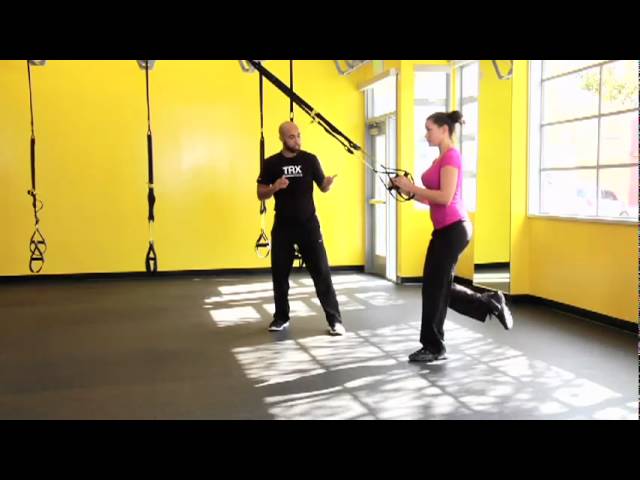
TRX for Hockey Training
Here, Carlos Teasdale from the TRX Programming Department shows us three exercises that will help you to increase your endurance and explosive power as well as your lateral strength and stability, an essential component of an effective hockey training program. Take our hockey assessment quiz for personalized drills based on your position and skill level. These exercises can be used to compliment an existing workout, or they can be done in a triple set format, which takes four minutes per round.
TAKE OUR TRAINING QUIZ
TRX Lunge (with Rock)
Benefits: Increases knee stability and strength
Adjust your TRX Suspension Trainer to mid calf length, stand facing away from the anchor point, place one foot in the foot cradles, centered with the anchor point, your shoulders aligned over your hips.
To perform the movement, drive your suspended knee back, lower your hips until your back knee is two inches from the ground and your front knee is at 90 degrees.
From here, push your front knee back towards the anchor point as far as you can without losing balance, hold and then bring your knee back to 90 degrees.
To return to standing, drive through the heel of the grounded leg and squeeze your glutes. Perform 10 TRX Lunges on each side and then rest for 30 seconds before moving on to the next exercise.
TRX Crossing Balance Lunge
Benefits: Improves lateral stability and strength
Adjust your TRX to mid length, stand facing the anchor point with feet shoulder width apart, grab the TRX with your elbows stacked under your shoulders.
Lift one leg, and with the weight evenly distributed in your grounded foot, drive the free leg behind the heel of the grounded leg, but don’t allow it to touch the ground.
To return to start, drive through the heel of the grounded leg and bring the free leg back to center. Repeat on the opposite side, performing 10 reps on each side. When finished, rest for 30 seconds and then move on to the third and final exercise.
TRX Single Leg Side Plank (with Abduction)
Benefits: Builds core and lateral hip strength
Adjust your TRX back to mid calf, lie on the ground facing sideways to the anchor point, place the bottom foot into both foot cradles, align your elbow under your shoulder.
Lift into a side plank position, keep your weight on your elbow. Keeping your top leg straight, lift it as high as possible, making sure to keep your hips stacked.
Hold for a moment, lower the top leg back down and then lower your hip back to the ground. Continue like this, holding the leg in the raised position for 10 seconds, for a total of three reps and then switch sides.
So there you have it, three great exercises that will help you develop functional strength for the sport of hockey. Performing these exercises slowly and in control is ideal. Remember to focus on form before you progress any of these movements.
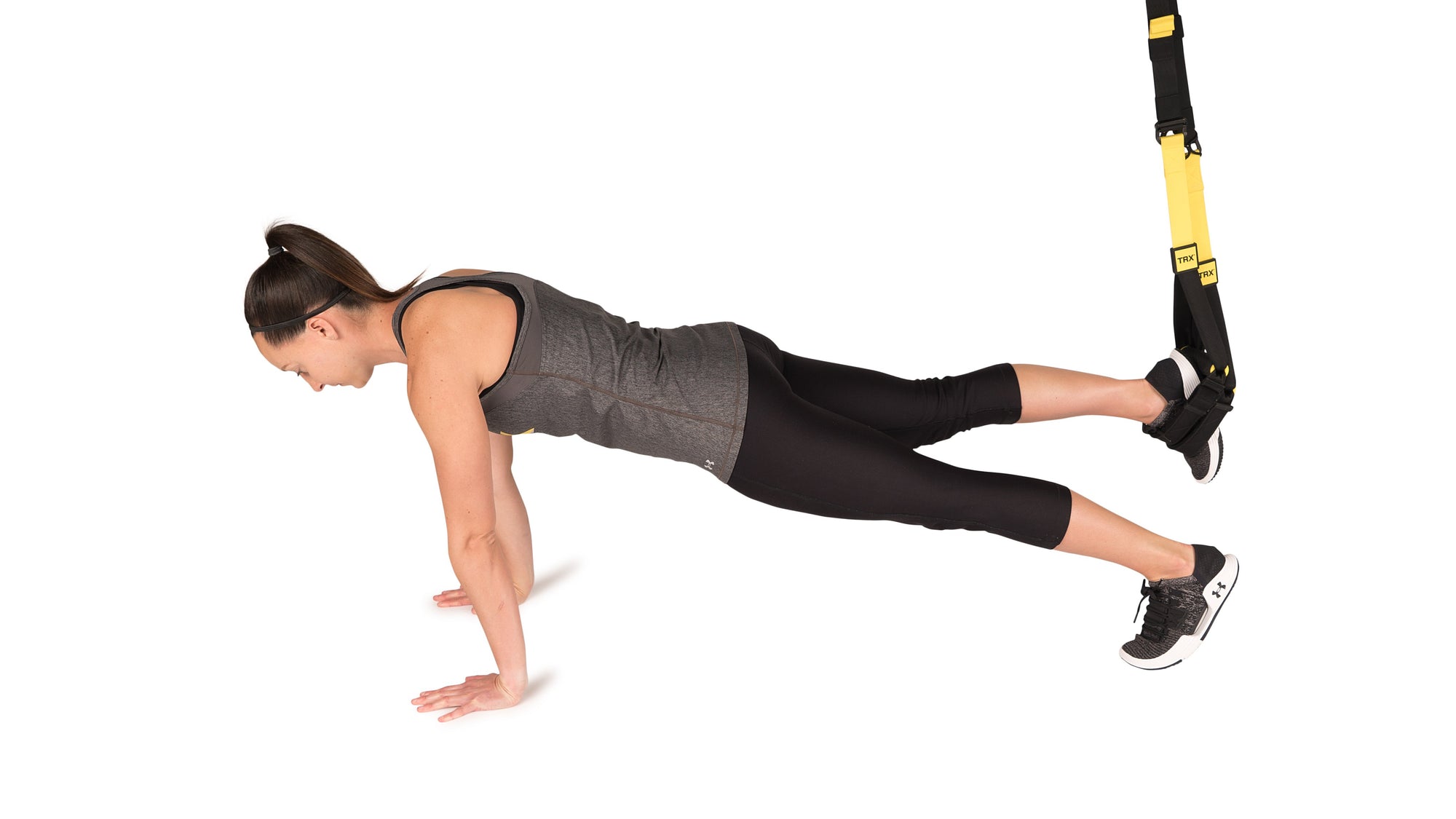
TRX for Hip Labrum Tear
Referred to as the new “in” surgery after A-Rod underwent the procedure in March 2009, a torn hip labrum will certainly place you on the DL. In this installment of Ask the Doctor, Dr. Perkash addresses a question from a member of the TRX Community on whether the TRX can be used both pre and post surgery to repair a torn labrum.
Question
I am going to have a surgery to repair a torn labrum in my hip in about a month. Want to find safe, effective exercises for your pre- and post-surgery rehabilitation? Take our quick assessment quiz to get a personalized training plan that works around your hip condition. I've been struggling to stay fit, and I've basically been limited to pull-ups and push-ups (everything else seems to increase my hip pain). What exercises can I do with my TRX Suspension Trainer to help with my rehab, both leading up to the surgery and afterwards? I'm a big fan of the TRX FORCE Program. I just haven't been able to do most of these movements without paying for it later.
TAKE OUR TRAINING QUIZ
Answer
The labrum is a rim of cartilage that helps to form part of the “socket” in the hip and shoulder joints. The cartilage may be torn or damaged and be a source of pain. Injuries to the shoulder labrum have been much more extensively studied, but more recently, minimally invasive hip surgery, known as hip arthroscopy, has become increasingly used.
Typical symptoms of a torn hip labrum include groin pain, clicking or snapping sensations of the hip and limited range of motion of the hip joint. Surgery for a torn hip labrum usually involves placing a camera through a small incision into the hip joint to better visual the joint and to trim or remove the torn portion of the labrum or in some cases, attempt to repair it. Recovery from surgery may take six to 12 weeks with a carefully directed rehabilitation program under the guidance of an orthopedic surgeon and a physical therapist.
Once adequate time has passed in order to recover from surgery, full rehabilitation exercises can be implemented in order to strengthen the musculature around the hip joint (i.e., hip flexors, gluteus muscles, hamstrings, etc…). If you are having pain with range of motion of the hip before your surgery, and physical therapy exercises are aggravating your symptoms rather than helping, I would suggest waiting until an appropriate time after your surgery (under the guidance of your physician) before initiating any new exercises of the affected hip.
Depending upon the findings during surgery and the nature of the excision/repair of the labrum itself, your rehabilitation may progress at a different rate. Again, you must follow the guidelines of your orthopedic surgeon and physical therapist before progressing in any rehabilitation program for your condition.
Ultimately, the following TRX exercises (with progressions) may be beneficial for improving the range of motion of the hip joint and strengthening the surrounding musculature:
TRX Step Side Lunge
TRX Step Back Lunge
TRX Balance Lunge
TRX Crossing Balance Lunge
TRX Hamstring Curl
TRX Hamstring Runner
TRX Plank
TRX Side Plank (with or without Hip Drop)
TRX Crunch
TRX Oblique Crunch
TRX Squat
TRX Single Leg Squat
TRX Low Row
TRX Overhead Back Extension
TRX Standing or Kneeling Roll Out
TRX Hip Hinge (Wide Stance or Single Leg)
For early stage hip rehabilitation, an assisted squat with a chair and an assisted march facing toward and away from a chair may be useful.
For more on how TRX Suspension Training bodyweight exercise is a safe, scalable and effective solution for you or your patients, visit our Sports Medicine page.
NOTE: Any medical information in this blog is of a general nature and not a substitute for the advice of a medical professional. If you need medical advice, see a doctor.
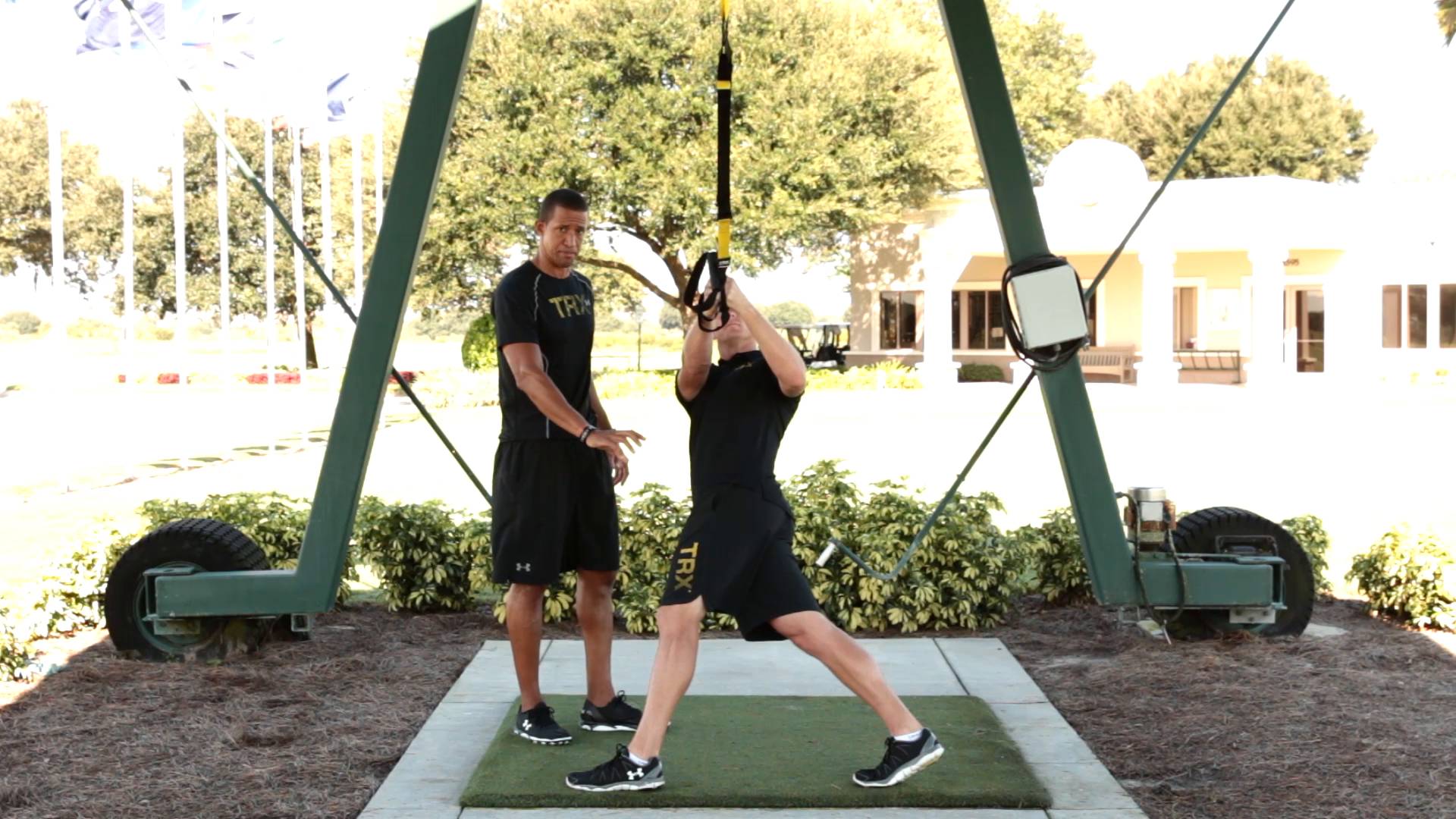
TRX for Golf: TRX Rotational Row To Press
A key to mastering your golf swing is training both rotational power and rotational resistance at impact. Want a golf-specific training plan? Take our quick assessment quiz. In this video, TRX Master Instructor Trevor Anderson demonstrates how the Suspension Trainer builds lower body stability and upper body strength, helping you hit straighter, longer, and more consistent shots through improved core rotation control at impact.
TAKE OUR TRAINING QUIZ
Watch the golf training video above and learn how to deliver your best golf game today
Learn how to put your Suspension Trainer into Single Handle Mode
TRX for Golf: Series 1
TRX for Golf: TRX Lunge with TwistTRX for Golf: TRX Golf Swing (Opposite Hands)TRX for Golf: TRX Rotational Row to PressTRX for Golf: Rip Rapid Response ImpactTRX for Golf: Rip Lunge to Press (with Rotation)TRX for Golf: Rip Backswing Hold (with Squat)
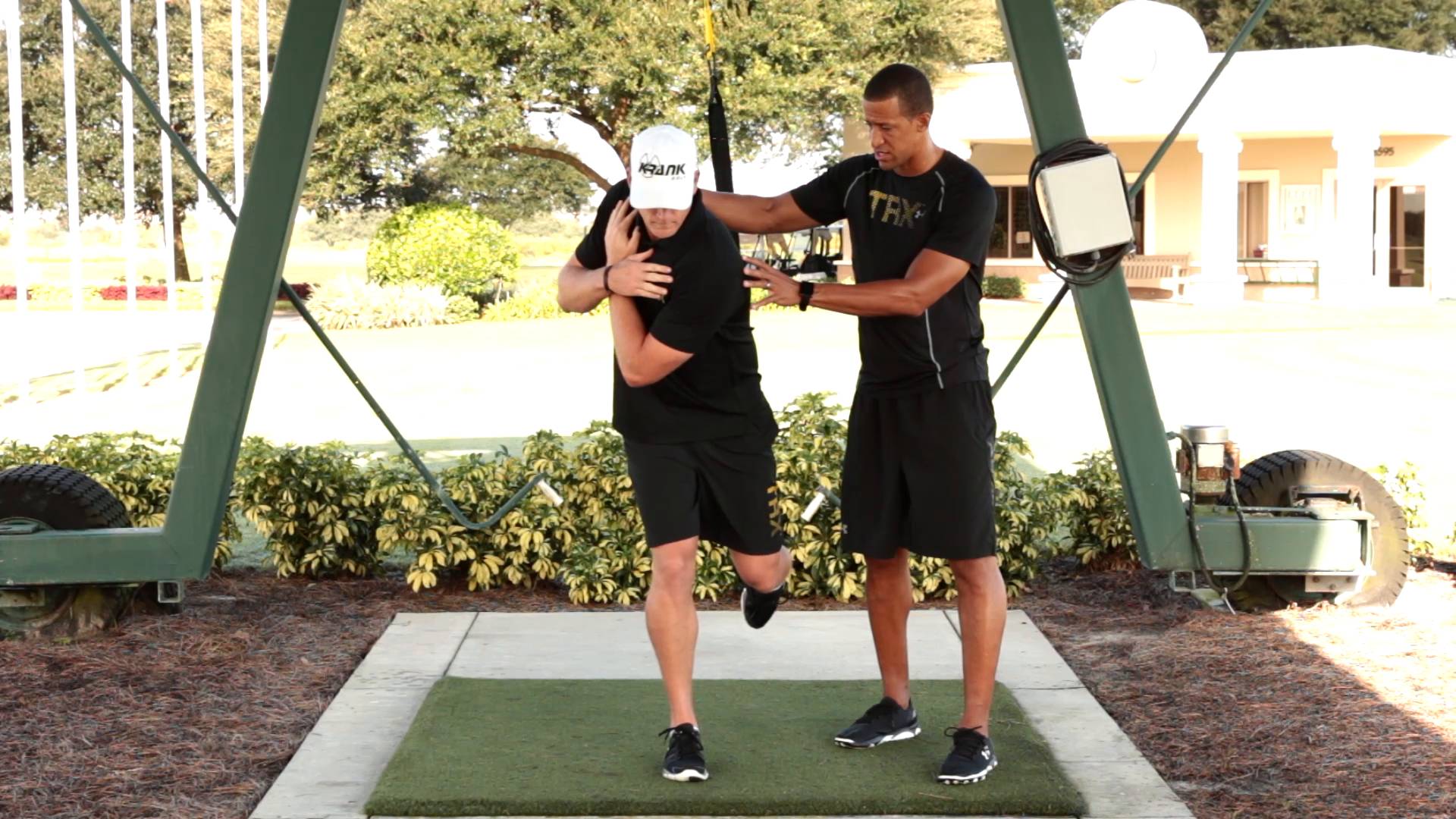
TRX for Golf: TRX Lunge With Twist
If you’re looking to take your golf game up a notch by bringing your scores down, then maintaining a consistent golf swing is key. In this short clip featuring TRX Master Instructor and Golf Performance Expert Trevor Anderson, you will learn how to use the TRX Suspension Trainer to hone lower-body stability and generate upper-body mobility. Trevor shows us how by practicing the TRX Lunge With Twist, golfers can perfect their golf swing by mastering control and generating consistency.
Watch the video above and learn how staying stabile will lead you to your perfect golf swing.
TRX for Golf: Series 1
TRX for Golf: TRX Lunge with TwistTRX for Golf: TRX Golf Swing (Opposite Hands)TRX for Golf: TRX Rotational Row to PressTRX for Golf: Rip Rapid Response ImpactTRX for Golf: Rip Lunge to Press (with Rotation)TRX for Golf: Rip Backswing Hold (with Squat)
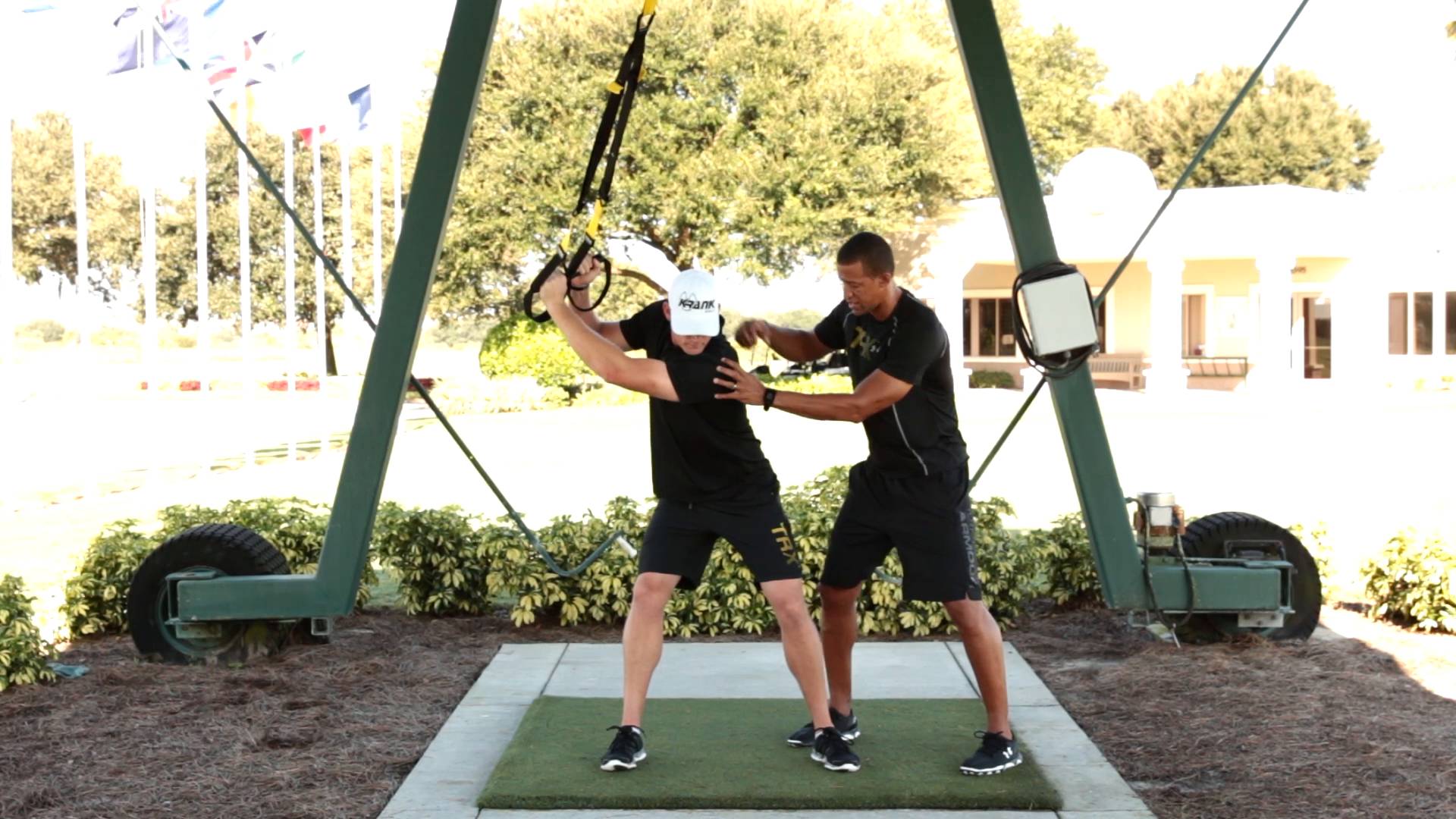
TRX for Golf: TRX Golf Swing (opposite hands)
Mastering the foundational movements of a basic golf swing is critical to creating consistency. Without an easy-to-replicate swing, your ability to confidently hit the ball with accuracy and speed will diminish, as will your overall scores. Want to find golf-specific exercises that match your playing level? Take our quick assessment quiz to get a personalized training plan to improve your game. In this short clip featuring TRX Master Instructor and Golf Performance Expert Trevor Anderson, you will learn how to use the TRX Suspension Trainer to reproduce key golf movement patterns, and to train your shoulder girdle to fully rotate with strength and ease while staying connected to the ground. Trevor shows us how practicing the TRX Golf Swing helps golfers engage in muscle and movement patterns that create consistency while rotating the shoulder.
TAKE OUR TRAINING QUIZ
Watch the golf video above and learn how to master the movements like a pro.
TRX for Golf: Series 1
TRX for Golf: TRX Lunge with TwistTRX for Golf: TRX Golf Swing (Opposite Hands)TRX for Golf: TRX Rotational Row to PressTRX for Golf: Rip Rapid Response ImpactTRX for Golf: Rip Lunge to Press (with Rotation)TRX for Golf: Rip Backswing Hold (with Squat)
You can also check out our resistance exercise equipment to add some extra flair to your workout.
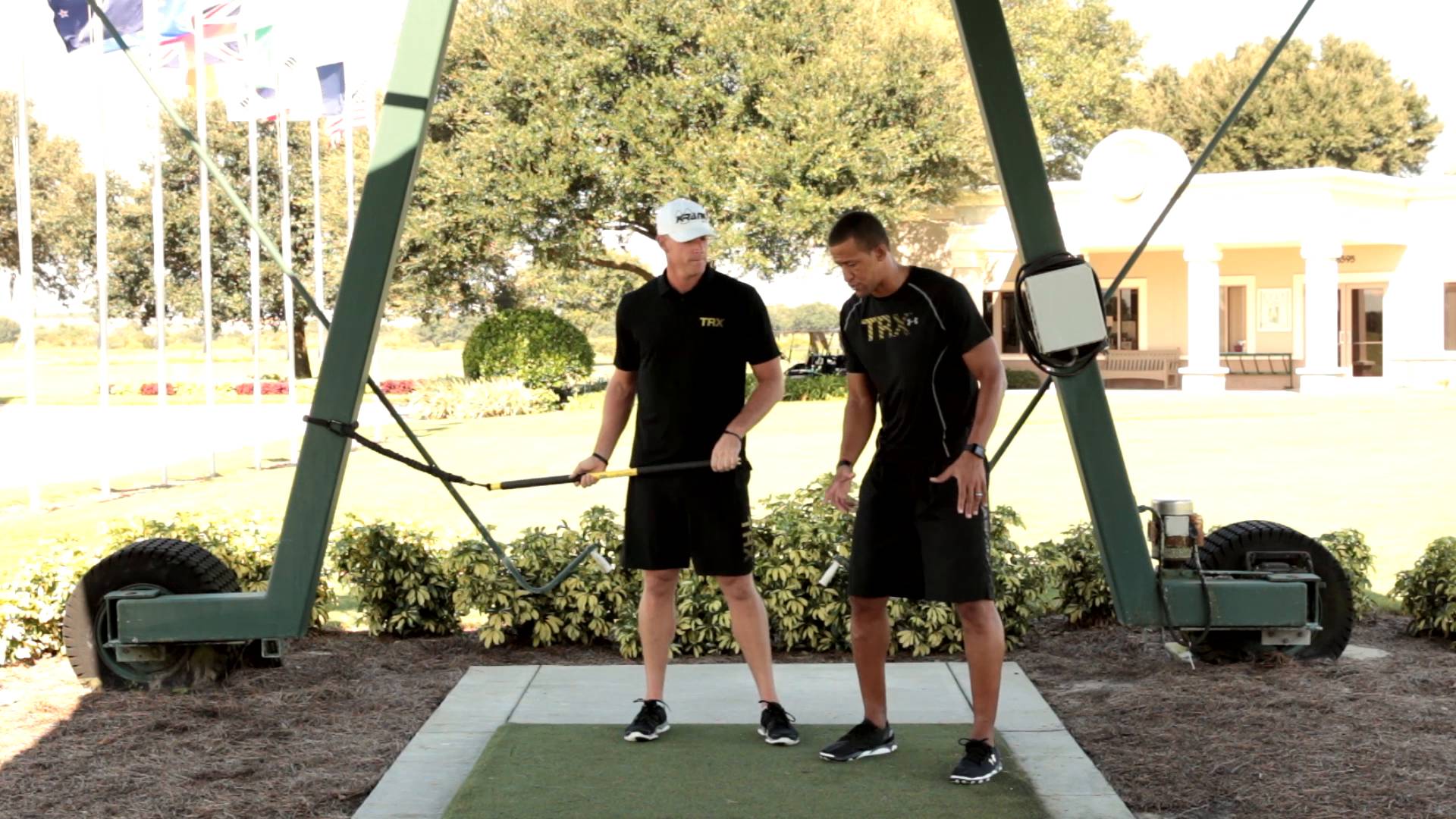
TRX for Golf: RIP Rapid Response Impact
When it comes to golf, and in particular when it comes to mastering your perfect golf swing, working on your coordination is key. In this short video featuring TRX Master Instructor and Golf Performance Expert Trevor Anderson, you will learn how the TRX Rip Trainer can be used to generate power from the ground up, while coordinating the movement patterns necessary to make a successful and powerful transition from backswing to downswing, and to prepare for impact. By training yourself to derive power from the ground, in addition to fine-tuning your coordinated sequence of movement, you will undoubtedly hit the ball further and with more consistency.
Watch the video above and learn how to optimize your coordination to dominate the course today!
TRX for Golf: Series 1
TRX for Golf: TRX Lunge with TwistTRX for Golf: TRX Golf Swing (Opposite Hands)TRX for Golf: TRX Rotational Row to PressTRX for Golf: Rip Rapid Response ImpactTRX for Golf: Rip Lunge to Press (with Rotation)TRX for Golf: Rip Backswing Hold (with Squat)
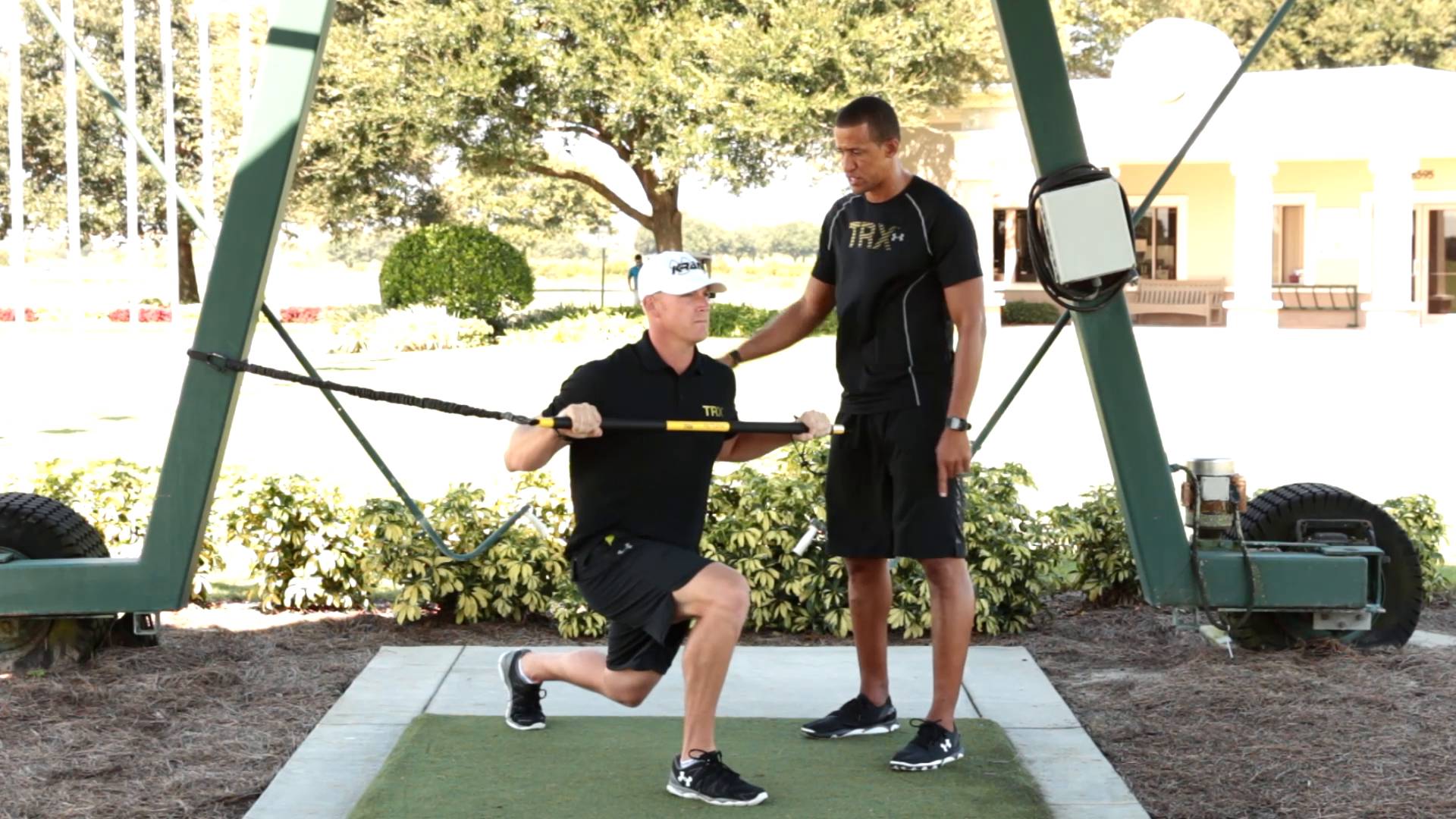
TRX for Golf: RIP Lunge To Press (with rotation)
Believe it or not, but after playing many rounds of golf, your golf swing can contribute to repetitive stress injury if your form is poor. In this short video featuring TRX Master Instructor and Golf Performance Expert Trevor Anderson, you will learn how the TRX Rip Trainer can be used to train yourself to properly rotate as you approach the backswing so that you can safely and effective transition into your downswing. By maintaining stability in the lower body, Trevor details how proper spinal alignment can go a long way to minimize excess low back pressure and prevent injury in the long term.
Watch the golf training video above and learn how to play golf safely and effectively for a lifetime!
TRX for Golf: Series 1
TRX for Golf: TRX Lunge with TwistTRX for Golf: TRX Golf Swing (Opposite Hands)TRX for Golf: TRX Rotational Row to PressTRX for Golf: Rip Rapid Response ImpactTRX for Golf: Rip Lunge to Press (with Rotation)TRX for Golf: Rip Backswing Hold (with Squat)
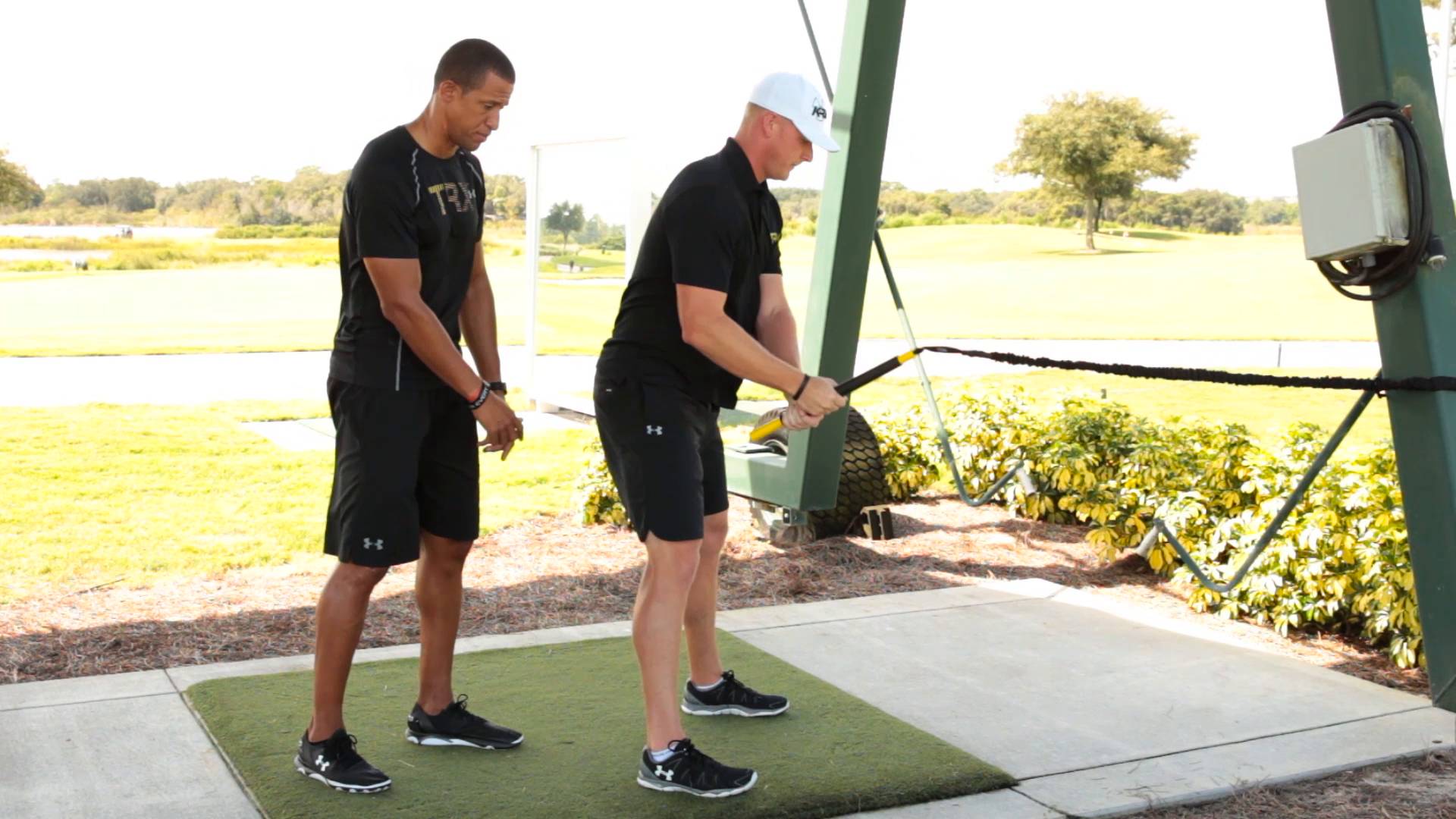
TRX for Golf: RIP Backswing Hold (with squat)
To achieve your best golf game, you must maintain a certain level of baseline strength to deliver a strong and controlled backswing all the way through impact. In this tutorial featuring TRX Master Instructor and Golf Performance Expert Trevor Anderson, you will learn how the TRX Rip Trainer, a monumental piece of resistance equipment, can be used to train yourself to stay firmly connected to the ground as you rotate from backswing to downswing. Holding the Rip Trainer at the top of your backswing as you work against the resistance of the Rip Cord, builds the strength and force necessary to transition the club to your downswing and drive the ball further. By developing a strong lower body connection, you stay stable, get mobile, and squat through a range of motion with control. Want to find the perfect golf-specific exercises for your game? Take our quick assessment quiz to get a personalized training plan that improves your swing power and consistency. Doing so ultimately empowers you to hit the ball further and with greater consistency.
TAKE OUR TRAINING QUIZ
Watch the golf video above and learn how you can train to build the lower body strength necessary to win every game!
TRX for Golf: Series 1
TRX for Golf: TRX Lunge with TwistTRX for Golf: TRX Golf Swing (Opposite Hands)TRX for Golf: TRX Rotational Row to PressTRX for Golf: Rip Rapid Response ImpactTRX for Golf: Rip Lunge to Press (with Rotation)TRX for Golf: Rip Backswing Hold (with Squat)
